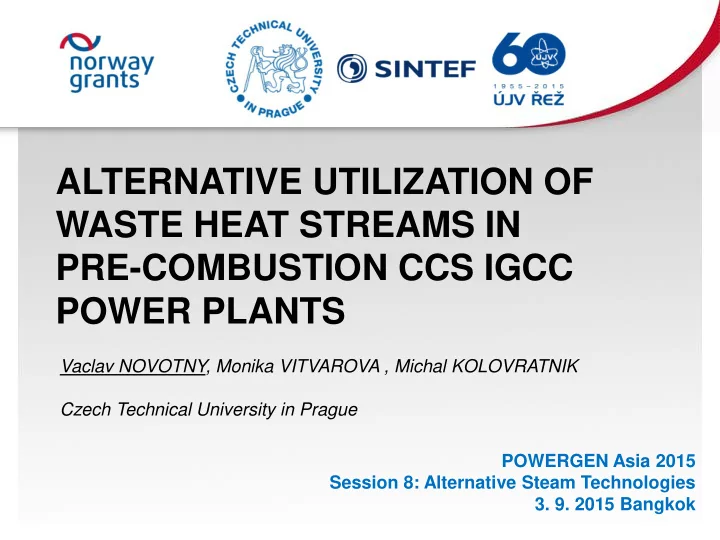

ALTERNATIVE UTILIZATION OF WASTE HEAT STREAMS IN PRE-COMBUSTION CCS IGCC POWER PLANTS Vaclav NOVOTNY, Monika VITVAROVA , Michal KOLOVRATNIK Czech Technical University in Prague POWERGEN Asia 2015 Session 8: Alternative Steam Technologies 3. 9. 2015 Bangkok
Integrated Gasification Combined Cycle plants with Carbon Capture and Storage • Carbon Capture and Storage – sustainable way to utilize abundant coal • Pre-combustion – high effeciency with perspective of lowest efficiency penalty • IGCC plants Internal waste heat streams Upon CCS integration Higher heat content in waste heat including low temperature heat Additional low temperature waste heat from capture If heat conventionally utilized – complicated inflexible system
Model Input, Reference Plants • 250 MWe designed power output (both with and without CCS technology) • fuel = lignite (app. 16 MJ/kg)
Model Input, Reference Plants Negative effects of CCS • Efficiency penalty • Decreased flexibility • Large amount of heat on relatively low temperature wasted IGCC IGCC - CCS Power output [MW] 250 250 Efficiency [%] 44.7 32.1 COE [c$/kWh] (25y) 6.5 9.45 Sophisticated system of waste heat regeneration • Heat transfer over large distance • Decreased flexibility • Waste heat utilization limited to high temperature heat, large portions of low temperature heat unutilizable
Waste heat utilization Considered as entirely independent units • Adjacent to heat source • Each having own cooling tower – Organic Rankine Cycle (ORC) • Industrial standard for WHR • Modular design • Higher efficiency at low temperature sources than RC
Waste heat utilization – Absorption Power Cycle • Temperature match of heat source during boiling and condensation • Most known APC is Kalina Cycle, here is proposed another one based on aqueous Lithium Bromide solution (known from absorption cooling) • Several advantages over ORC and Kalina Cycle – Clean water vapour in turbine – Potential for higher turbine efficiency at low power unit (high volumetric steam flow) – Potential for higher efficiency (especially heat source below 120 ° C)
Waste heat utilization – Absorption Power Cycle • Better efficiency than ORCs below 110-120 ° C • Currently under development at Czech Technical University (planned experimental rig to confirm major aspects)
Waste heat in IGCC Air Separation Unit • Compressor intercooling and aftercooling – Waste heat as hot water 100-200 ° C
Waste heat in IGCC Coal Dryer • Fluid bed dryer (WTA type) • Exiting mixture of air and vapours ~ 100 ° C
Waste heat in IGCC Syngas cooling • Cooling down syngas from ~ 160 ° C • High content of condensing vapours • Clean H2 rich gas much smaller heat capacity
Waste heat in IGCC CO2 compression • Compressor intercooling and aftercooling • Water at temperature > 80 ° C
Waste heat in IGCC Flue gas from HRSG • Flue gas leaving HRSG at ~ 100 ° C • After Rectisol CO2 capture very clean (minimum of S) • Even with 3 pressure system hard to recover heat below 100 ° C • Therefore proposed “ Superbottoming “ unit after steam cycle
Results of WHR units application W/o CCS Output of steam System Stream Net output [kW] WHR unit type integration [kW] Air Compressors 359 APC ASU Oxygen compressors 2 428 ORC (Isopentane) 1 863 Coal dryer Waste vapours stream 450 APC Syngas cooling N.A. - Used for regenerative fuel preheating CO2 compression N.A. -Capture not implemented “Super - bottoming” unit Flue gas 1 685 APC Total change in plant net output 3 059 With CCS Output of steam System Stream Net output [kW] WHR unit type integration [kW] Air Compressors 500 APC ASU Oxygen compressors 3 381 ORC (Isopentane) 2 316 Coal dryer Waste vapours stream 627 APC Syngas cooling Hot syngas 10 044 ORC (Isobutane) 8 467 CO2 compression Stage 2-7 771 APC “Super - bottoming” unit Flue gas 1 324 APC Total change in plant net output 5 864
Results of WHR units application • Additional power output – increase in plant efficiency • Higher impact on CCS plant IGCC - CCS IGCC Original power output 250 250 [MW] Power output with WHR 255.9 253.1 [MW] Original efficiency [%] 32.1 44.7 Efficiency with WHR [%] 34.2 45.2 Efficiency increase [p.p.] 2.1 0.5
Technical Aspects • ORC units are available technology • APC in research phase, but perspective • Possible further increase of output by connecting to plant cooling system (but brings lower autonomy of units) • Cooling demand partially substituted by heat engines • Possible partial application to current plants • “ Superbottoming “ for current and non CCS plants – careful for Sulphur content
Economic Aspects • WHR unit installing cost around 2000 $/kWe – IGCC plant alone - 1400-2200 $/kWe (w/o CCS) - 1500-3200 $/kWe (w/ CCS) • Minimal operational cost of units
Conclusion • Application of WHR modular units into IGCC – Improves plant flexibility – Increases efficiency (2.1 p.p. For CCS) – Decreases cost of energy (1% for CCS, 65% capacity factor) • Effect larger for CCS plants • For very low temperatures proposed novel absorption power cycle
THANK YOU FOR YOU ATTENTION
Recommend
More recommend